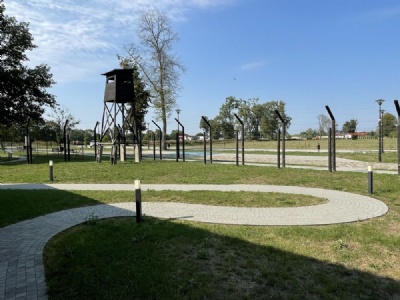Dobiegniew – Oflag II C
About one kilometer southwest of Dobiegniew (german Woldenberg) in western Poland, a prisoner of war camp for Polish prisoners was established in October 1939 and named Stalag II C - Woldenberg. The camp became a camp from which the Germans coordinated various groups of prisoners for slave labor in the region. The number of prisoners in the camp itself was quite low, about 500 in number, and they were housed in tents and forced to build barracks for future living quarters. The lack of food, medicines, adequate housing paid its toll during the winter of 1939/40 when several prisoners died. In May 1940, the camp was given a new function and became a prisoner of war camp for Polish officers and orderlies and was named Oflag II C - Woldenberg (Oflag, German offizier warehouse).
The camp was about 25 hectares in size and consisted when it was completed of about 25 brick buildings for prisoners and another six buildings for various purposes, kitchen, dining hall, theater hall, teaching, hospital and administration. Prisoners did not need to slave labour and they were allowed to practice cultural activities and prisoners was allowed to study and teached by other fellow prisoners. Some prisoners took university courses in the camp which they after the war could cater. The prisoners were also allowed to set up theatrical performances and shown to other prisoners and camp administration.
The treatment of the prisoners was comparatively with the concentration camps and prisoner-of-war camps (Stalag) better. A few escape attempts were made during the war, some succeeded while others failed. Among the prisoners were thirteen Olympic participants and for this reason an unofficial Olympic games was held in the camp in the summer of 1944. Before the war, the 1944 Olympics was supposed to be held in London, but due to the war, the games were postponed and moved til 1948. In 1942, the number of prisoners pesked when almost 7,000 prisoners were incarcerated. The camp was the largest in the region (West Pomerania) and prisoners from smaller Oflag were brought to Woldenberg. In january 1945, the germans began evacuating the camp westward and by the end of january the camp was liberated by the Soviet Red Army.
Current status: Demolished with museum (2024).
Location: 52°57'29.86"N 15°44'16.25"E
Get there: Car.
Follow up in books: Bob, Fedorowich, Kent: Prisoners of War and Their Captors in World War II (1996).












In central Dobiegniew there is a large monument and at the former camp site is a museum. Some brick buildings at the site might be remnants of te camp, but I’m not sure. Watchtower and fence are reconstructed. The museum is quite interesting and modern with various stories and objects from the camp. In a pavilion there is a model of the camp and outside the pavilion there is a small path with information boards placed along it.